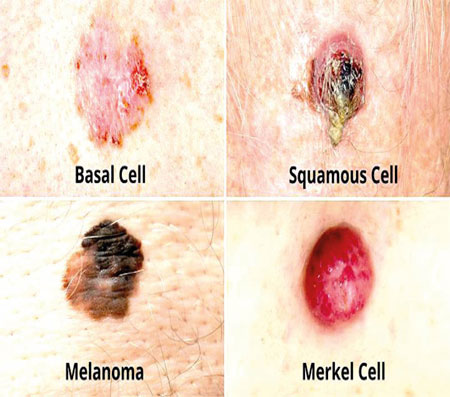Skin cancer is the rampant growth of abnormal skin cells. The cause is usually excessive exposure to ultraviolet (UV) radiation, either from sunlight or indoor tanning devices.
UV radiation can damage the DNA of skin cells, resulting in mutations (genetic defects). These muta-tions instruct the abnormal skin cells to multiply at a rapid pace, forming malignant tumors. (2) Basal cell carcinoma and squamous cell carcinoma, the most common types of skin cancer, tend to develop on parts of the body that get a lot of sun exposure, such as the face, ears, neck, lips, and the backs of the hands.
A history of serious sunburns can also raise skin cancer risk.
Melanoma is much less prevalent than other types of skin cancer but more dangerous. It, too, is typically related to overexposure to UV radiation, but can also develop because of inherited genetic factors. (3)
Skin cancer is easiest to treat when it is small and has not yet spread. Common early symptoms include an open sore that repeatedly bleeds and crusts over; pink bump with raised edges and a depression in the center; pink, reddish, or brown patches; or, in the case of melanoma, a mole that changes in shape or size.
To understand skin cancer, you need a basic under-standing of skin cells. There are three main types in the epidermis (the top layer of skin), all of which have the potential to become malignant. Squamous Cells These flat cells are in the outer part of the epidermis. The body continually sloughs off old squamous cells as it makes new ones.
Basal Cells These cells start in the base of the epi-dermis and base of the hair follicle. They mature and become larger as they grow into the upper level of the skin (toward the surface) to become new squamous cells.
Melanocytes These cells produce melanin, a pigment that gives skin its brown or tan color. They act as a natural sunscreen, helping protect layers of skin below the epidermis from UV damage. There are three main categories of skin cancer as well as a number of rare kinds. Basal Cell Carcinoma This cancer accounts for about 80 percent of all cases of skin cancer. It is almost always completely curable, rarely spreading to other parts of the body. Left untreated, however, it can destroy skin, deep tissue, and bone, becoming disfiguring or causing functional problems.
Squamous Cell Carcinoma Accounting for about 20 percent of all skin cancers, this carcinoma is also highly treatable.
However, it is more likely than basal cell carcinoma to spread.










